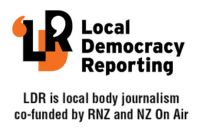Greenstreet 'not our finest moment'

The impact of the minimum flow regime on the Ashburton/Hakatere River will come under the spotlight again next month, as Environment Canterbury apologises for its handling of the Greenstreet Creek crisis.
ECan chief executive Dr Stefanie Rixecker confirmed a report into the impacts of the new minimum flows is expected in April, in response to a request for information from the Ashburton Water Zone Committee.
“The rules associated with the minimum flows provided consent holders some lead in time to implement the minimum flow levels, so we are in the first irrigation year with the flows fully implemented now.”
The restrictions came into effect on July 1, 2023, following an Ashburton River consents review between 2018-2022.
Ashburton Water Zone committee chair Bill Thomas, presenting to the Ashburton District Council last week, said they have “caused a lot of disharmony”.
“We haven’t seen a huge improvement in the river or any changes, and the irrigation has probably halved.”
The zone committee has asked ECan for a review of the review, outlining the impacts of introducing the minimum flows and if it was delivering the expected outcomes.
Ashburton Mayor Neil Brown said it will be interesting to see if the science behind the changes has happened.
The impacts came to a head last week as the Greenstreet Creek dried up.
Following pleas from local landowners, Rixecker used emergency powers to allow them to divert water from O’Sheas Creek into Greenstreet Creek on March 21.
ECan director of science Dr Tim Davie told the zone committee on Tuesday the decision was “a one-off”.
“If it’s done under emergency powers, it’s not something that can just be easily repeated,” he said.
He apologised to the committee and the community over the regional council’s handling of the Greenstreet Creek situation.
“It wasn’t our finest moment.
“We didn’t do a great job.
“The things that we didn’t do well was keeping people informed, and in particular I think we hadn’t been proactive in preparing for the changes that were coming from the plan change.”
Meanwhile, a Greenstreet landowner says the solution for the waterway woes at Greenstreet is for ECan to take a back seat.
A Greenstreet delegation presented to the zone committee on Tuesday where Linda Bray said there was a disconnect between the field and the office, and that local knowledge should be relied upon more than computer-generated assumptions.
“People got tied up in bureaucracy while the creek was dying,” Bray said.
“It should not take adverse publicity within the media for authorities to come to the party.
“The residents are saying put aside what the science and trained engineers are saying and put a little faith in the ability of those who have been doing a job for the last 40 years to maintain an ecosystem that is precious to them.”
The focus is on a longer-term solution for Greenstreet Creek and Bray put one forward.
“We think there is a pretty good solution for the immediate and medium term in ECan stepping aside and letting the people with the commitment and knowledge manage the creek within the ability of natural resources they will have to work with.”
Davie said the question now is what happens in the future, “because this will happen again”.
The first summer under the new minimum flows has had the lowest flows in February and March in 42 years on the North Ashburton Branch at the old weir site in the foothills, Davie said.
“Into the future, we expect that there will be more of these types of events [due to climate change].
“There will be longer dries, so because of that we are expecting to see rivers dry up and streams dry up and those are the hard calls that are going to have to be made into the future.”
The introduction of the minimum flows was guided by the RMA process and ECan is aware some people aren’t happy, “but it was a robust process”, Davie said.
“Once we have been through that we have to stand by it, and implement the rules that come out from the consents and therefore from the plan.”
The minimum flows are aimed at keeping more water in the Ashburton/Hakatere River catchment.
By Jonathan Leask

